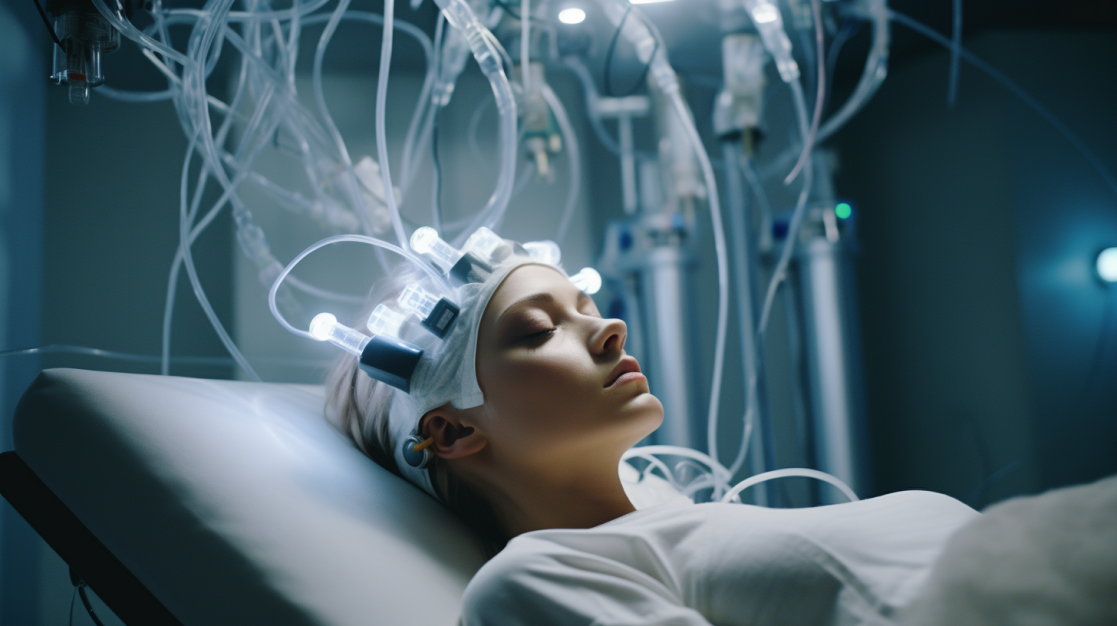New research demonstrates that repeated focused ultrasound treatments can have antidepressant-like effects in rats.
The non-invasive technique was able to improve performance on a common test of depressive behaviors.
While not a silver bullet solution, focused ultrasound represents an exciting potential alternative for depression treatment.
Key Facts:
- Focused ultrasound (FUS) uses targeted sound waves to manipulate brain tissue.
- When paired with circulating microbubbles, FUS can temporarily open the blood-brain barrier.
- 2 weekly FUS treatments improved rat behavior on the forced swim test, a common measure of antidepressant effects.
- 1 or 3 weekly treatments did not have the same benefits.
- The antidepressant effects had diminished 5 weeks after treatment.
- Potential mechanisms include promoting neurogenesis or altering neuronal excitability.
Source: Behav Brain Res.
Depression & Focused Ultrasound (FUS)
Depression is one of the most common mental health disorders, affecting millions worldwide.
While treatments exist, many patients fail to respond adequately to first or even second-line interventions like psychotherapy and antidepressant medications.
This underscores the need for novel solutions that can provide relief to those with stubborn depressive symptoms.
One emerging technique is focused ultrasound (FUS), which uses targeted sound waves to manipulate brain tissue and function.
When applied at the right parameters in combination with circulating microbubbles, FUS can temporarily “open” the blood-brain barrier, improving access to the brain for medications or other compounds.
Intriguingly, previous research found this FUS technique can promote neurogenesis (the growth of new neurons) when directed at the hippocampus, a brain region critical for emotions and memory.
Since many antidepressant treatments share the ability to increase hippocampal neurogenesis, a team of Canadian researchers decided to test whether FUS could also have antidepressant effects in a rat model.
Focused Ultrasound for Depression in Rats (Study)
The researchers subjected rats to 1, 2, or 3 weekly treatments of FUS targeted at the hippocampus.
Each session involved first injecting the rats with microbubbles, applying the ultrasound waves, and then imaging the rats to confirm the desired focusing of the treatment.
Before and after the FUS treatments, the rats went through a modified forced swim test (FST) to measure depressive behaviors like how much they swam versus remaining immobile.
The FST is a common screening test for antidepressant effects in animal models.
Some rats also received an injection of the antidepressant fluoxetine as a positive control.
The researchers scored videos of the FST sessions for time spent swimming, climbing, or immobile.
They compared the FUS-treated rats to controls who did not receive ultrasound sessions.
Statistical tests were used to determine if the different number of treatments had a significant impact on behaviors.
Antidepressant effects observed in rats
The fluoxetine-injected rats showed the expected antidepressant-like effects on the FST at baseline, demonstrating the test’s validity.
The rats receiving 2 weekly FUS treatments displayed more swimming activity and less immobility on the FST compared to controls when tested 1 week after their last session.
This suggests FUS had antidepressant effects on their behaviors.
However, rats getting only 1 FUS treatment did not show behavioral differences from controls on the later FST.
The antidepressant benefits of FUS did not appear with just one session.
Interestingly, rats given 3 weekly treatments also failed to display robust antidepressant effects compared to controls.
The benefits seemed specific to 2 treatment sessions.
For all groups, the behavioral effects had disappeared when rats were tested again 5 weeks after starting FUS.
The antidepressant benefits were not long-lasting.
FUS Treatments an Alternative Depression Treatment

This exciting study provides initial evidence that repeated FUS treatments could offer antidepressant activity, at least in the short term.
While not a magic bullet, FUS represents a potential alternative for patients who fail to respond well to medications or therapy.
The reasons for FUS’s behavioral effects are still unclear.
Possibilities include promoting neurogenesis, altering neuronal excitability, or some combination.
Intriguingly, the antidepressant benefits only occurred after 2 weekly sessions, not with 1 or 3.
This suggests certain treatment parameters are critical, and overdoing FUS may diminish positive effects.
More research is needed to optimize techniques and unravel mechanisms.
The lack of longer-term benefits is also a key limitation.
Still, the feasibility of using a non-invasive method like ultrasound to improve depression symptoms is extremely promising.
Unlike medications or implants, FUS can be carefully targeted to specific brain regions.
Opening the blood-brain barrier also creates possibilities for enhanced drug delivery in combination with ultrasound.
Potential Antidepressant Mechanisms of Focused Ultrasound
There are a few leading theories on how focused ultrasound may exert antidepressant effects:
Neurogenesis (Hippocampal)
Research shows many antidepressant treatments promote the growth of new neurons (neurogenesis) in the hippocampus.
Prior studies found that focused ultrasound directed at the hippocampus can boost neurogenesis.
The creation of new brain cells may be a key process underlying the behavioral changes seen in this study.
However, the timing makes this theory uncertain.
The antidepressant effects occurred just 1 week after FUS, while neurogenesis seems to require longer timescales.
Measuring markers of neurogenesis at different timepoints after FUS could provide more insights.
Neuromodulation
FUS is known to alter neuronal excitability and activity in the short-term.
These neuromodulatory effects may change mood circuits to produce antidepressant actions.
On the other hand, similar ultrasound parameters have not caused neuromodulation lasting a full week in other studies.
And overdoing the treatments seemed to eliminate benefits here.
So neuromodulation may not fully explain the results.
Enhanced Drug Delivery (BBB Opening)
By opening the blood-brain barrier, focused ultrasound can increase delivery of circulating drugs or compounds to the brain.
Enhanced access to neurochemicals or medications could contribute to antidepressant effects.
Testing FUS alongside administration of different drugs may reveal synergistic effects at lower doses than normal.
This could provide a new target delivery strategy for depression treatments.
Focused Ultrasound in Depression: Moving Forward
While promising, much more research is needed to validate focused ultrasound for depression and understand the mechanisms involved.
Next steps include:
- Testing different ultrasound parameters and microbubble doses to optimize treatment effects
- Expanding studies across more animal models and larger sample sizes
- Measuring biomarkers like neurogenesis over multiple timepoints after FUS treatment
- Combining FUS with antidepressant medications or compounds to assess synergies
- Applying advanced imaging to map brain changes induced by focused ultrasound
- Moving to clinical trials in patients if safety and effectiveness are demonstrated
As a non-invasive approach, FUS offers advantages over medications or implanted devices in terms of both safer targeting and patient acceptability.
New innovations in ultrasound technology could make clinical translation even more feasible going forward.
Conclusion: FUS is a Potential Antidepressant
Focused ultrasound is an exciting non-invasive technique for manipulating brain function.
This initial study suggests it may hold promise as a new avenue for treating depression when applied in specific repeated sessions.
More research is critical to fully demonstrate FUS’s antidepressant effects and the mechanisms involved.
But the possibilities are compelling for this technology to improve patient outcomes in the future, especially for those resistant to first-line options.
Guarded optimism is warranted.
References
- Study: Antidepressant effects of focused ultrasound induced blood-brain-barrier opening
- Authors: Skyler J. Mooney et al. (2018)







